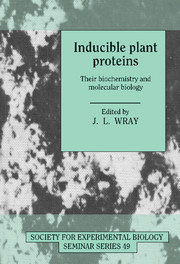Book contents
- Frontmatter
- Contents
- List of Contributors
- Preface
- Metal-binding proteins and metal-regulated gene expression in higher plants
- Phosphate starvation inducible enzymes and proteins in higher plants
- Nitrate reduction in higher plants: molecular approaches to function and regulation
- Inducibility of the glutamine synthetase gene family in Phaseolus vulgaris L.
- Expression and manipulation of genes involved in phenylpropanoid biosynthesis
- Biochemistry and molecular biology of CAM
- ABA- and GA-responsive gene expression
- Regulation of gene expression, ethylene synthesis and ripening in transgenic tomatoes
- Induction of nodulin genes and root nodule symbiosis
- Systemic acquired resistance: an inducible defence mechanism in plants
- Biochemistry and molecular biology of the anaerobic response
- The heat shock response in transgenic plants: the use of chimaeric heat shock genes
- Biochemistry and molecular biology of cold-inducible enzymes and proteins in higher plants
- GBF-1, GBF-2 and GBF-3: three Arabidopsis b-Zip proteins that interact with the light-regulated rbcS-1A promoter
- Index
Nitrate reduction in higher plants: molecular approaches to function and regulation
Published online by Cambridge University Press: 06 July 2010
- Frontmatter
- Contents
- List of Contributors
- Preface
- Metal-binding proteins and metal-regulated gene expression in higher plants
- Phosphate starvation inducible enzymes and proteins in higher plants
- Nitrate reduction in higher plants: molecular approaches to function and regulation
- Inducibility of the glutamine synthetase gene family in Phaseolus vulgaris L.
- Expression and manipulation of genes involved in phenylpropanoid biosynthesis
- Biochemistry and molecular biology of CAM
- ABA- and GA-responsive gene expression
- Regulation of gene expression, ethylene synthesis and ripening in transgenic tomatoes
- Induction of nodulin genes and root nodule symbiosis
- Systemic acquired resistance: an inducible defence mechanism in plants
- Biochemistry and molecular biology of the anaerobic response
- The heat shock response in transgenic plants: the use of chimaeric heat shock genes
- Biochemistry and molecular biology of cold-inducible enzymes and proteins in higher plants
- GBF-1, GBF-2 and GBF-3: three Arabidopsis b-Zip proteins that interact with the light-regulated rbcS-1A promoter
- Index
Summary
Introduction
Nitrate from the soil is the main nitrogen source for most higher plants (Beevers & Hageman, 1969; Guerrero, Vega & Losada, 1981; Blevins, 1989). To increase both the growth and yield of those many crops that are unable to fix atmospheric nitrogen, farming has made use of nitrate-providing biological by-products or chemical fertilisers. There is a need to improve the control of the level of nitrate in the soil, to avoid water and atmospheric environmental pollution, as well as to lower production costs (Crawford & Campbell, 1990). For health concerns in humans and animals, there is also a need to maintain a low level of nitrate in food and forage plants. For these reasons, besides soil science, understanding which factors are involved in nitrate uptake and assimilation by plants and how these systems operate is of importance.
Nitrate absorbed by roots is assimilated inside the plant cell in the cytoplasm (see Fig. 1) either after transport from the outside through the plasma membrane, or through the tonoplast from the vacuole, where large amounts of nitrate can be accumulated. Both processes are active, and unfortunately remain poorly understood at a molecular level (Wray, 1988; Crawford & Campbell, 1990). Nitrate assimilation inside the cell involves two enzymes, nitrate reductase (NR), which reduces nitrate to nitrite, and nitrite reductase (NiR), which reduces nitrite to ammonium. This overall process is an 8-electron reduction step.
- Type
- Chapter
- Information
- Inducible Plant ProteinsTheir Biochemistry and Molecular Biology, pp. 45 - 78Publisher: Cambridge University PressPrint publication year: 1992
- 14
- Cited by



